Consumer Behavior: Critical Analysis and Recommendations
VerifiedAdded on 2022/12/26
|9
|2540
|84
Report
AI Summary
This report provides a critical analysis of consumer behavior, examining how consumers react to products, services, and marketing efforts. It delves into consumer behavior theories such as Marshallian Economics, Psychoanalytic theory, Veblinian Social-Psychological model, Theory of Reasoned action, and Engel, Kollet, Blackwell model, and Motivation need theory, and Hawkins Stern Impulse buying. The report explores the application of these theories, particularly in the context of the COVID-19 vaccine, highlighting factors that influence consumer decisions. The research methodology includes both qualitative and quantitative approaches, utilizing primary data from customer questionnaires and secondary data from literature reviews. Ethical considerations such as validity, voluntary participation, and confidentiality are addressed. The report offers recommendations to the government on strategies to increase vaccine uptake, including safety measures, technology-based communication, celebrity endorsements, and public awareness campaigns through various media channels. The conclusion emphasizes the importance of understanding consumer behavior for marketers to address diverse consumer segments effectively.
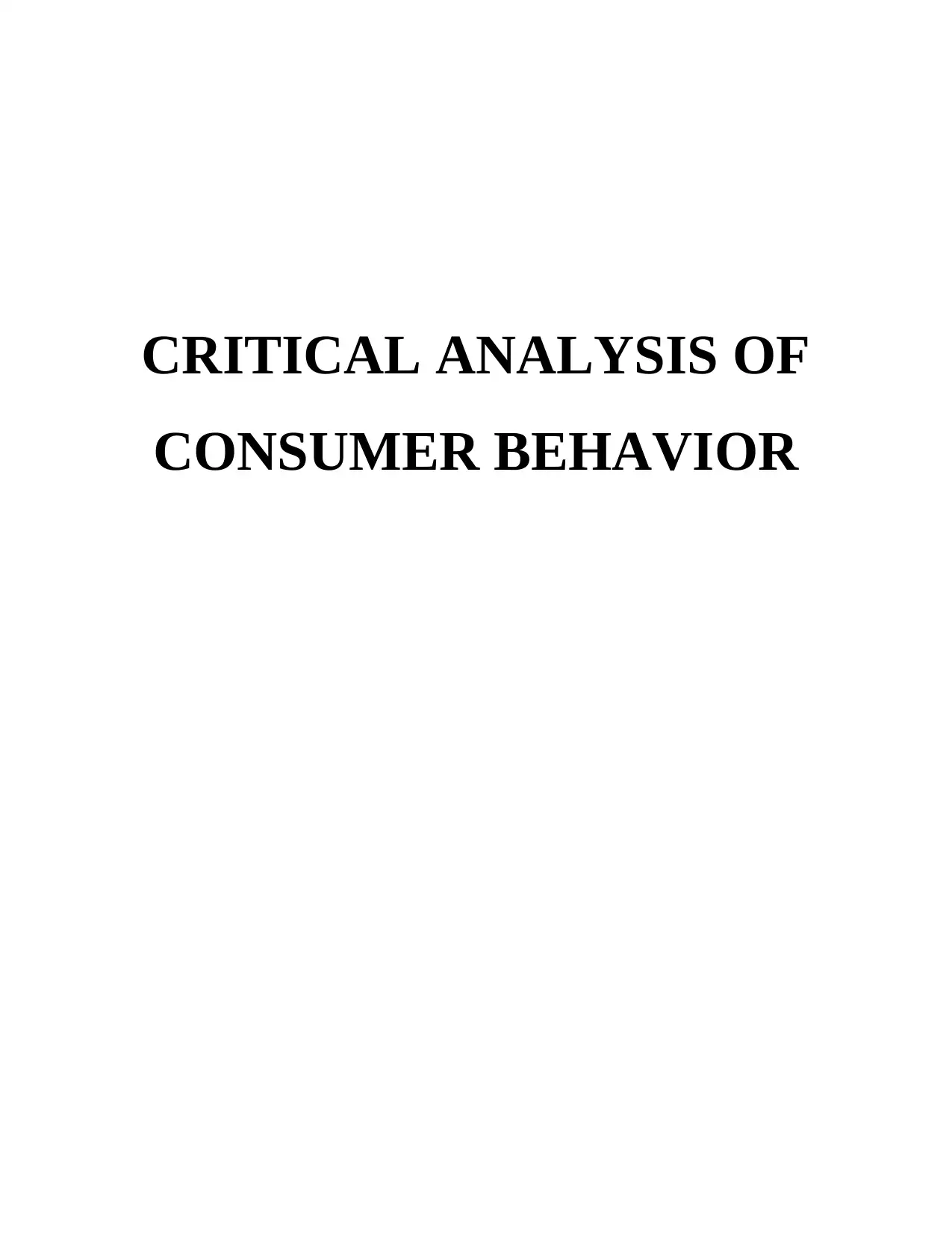
CRITICAL ANALYSIS OF
CONSUMER BEHAVIOR
CONSUMER BEHAVIOR
Paraphrase This Document
Need a fresh take? Get an instant paraphrase of this document with our AI Paraphraser
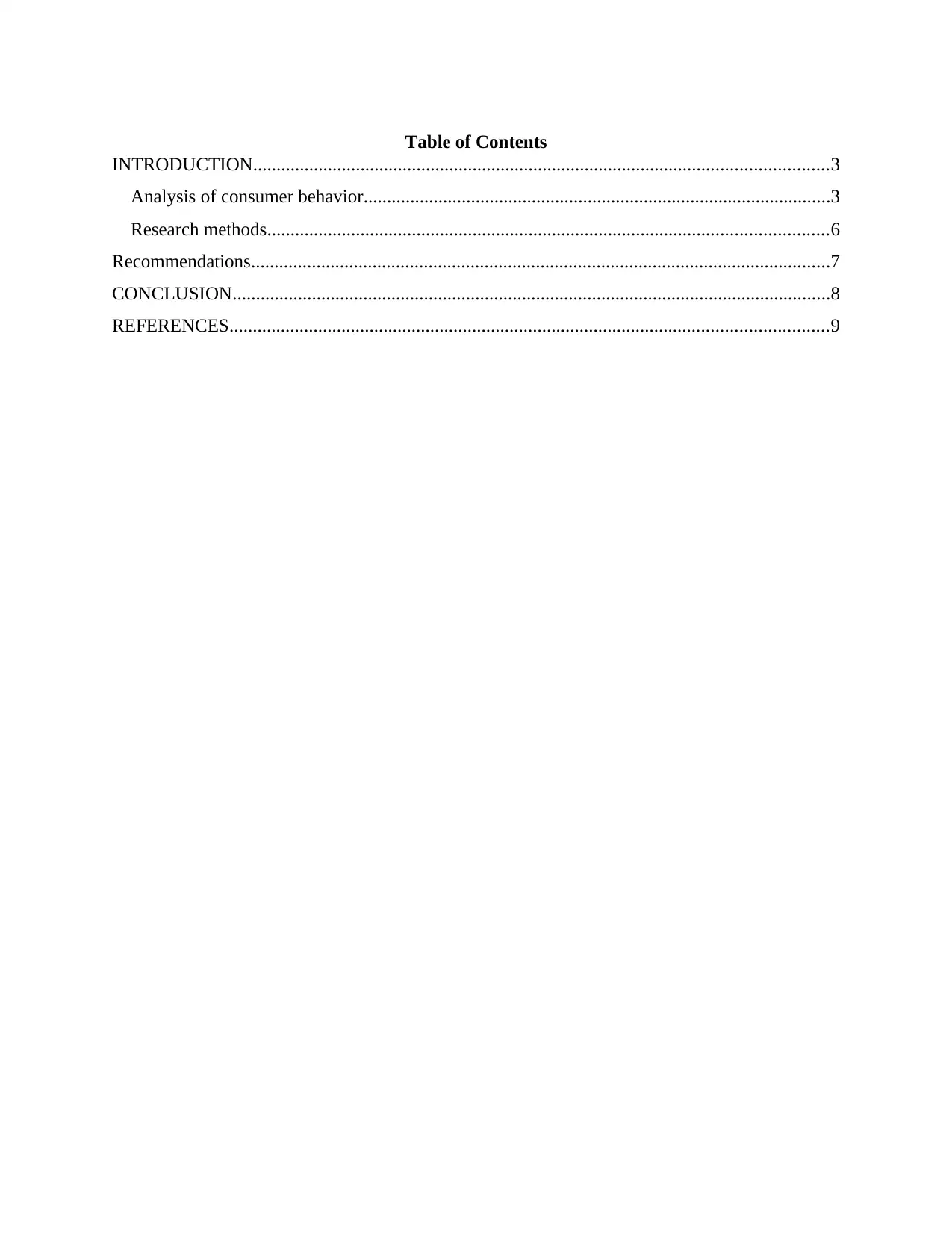
Table of Contents
INTRODUCTION...........................................................................................................................3
Analysis of consumer behavior....................................................................................................3
Research methods........................................................................................................................6
Recommendations............................................................................................................................7
CONCLUSION................................................................................................................................8
REFERENCES................................................................................................................................9
INTRODUCTION...........................................................................................................................3
Analysis of consumer behavior....................................................................................................3
Research methods........................................................................................................................6
Recommendations............................................................................................................................7
CONCLUSION................................................................................................................................8
REFERENCES................................................................................................................................9
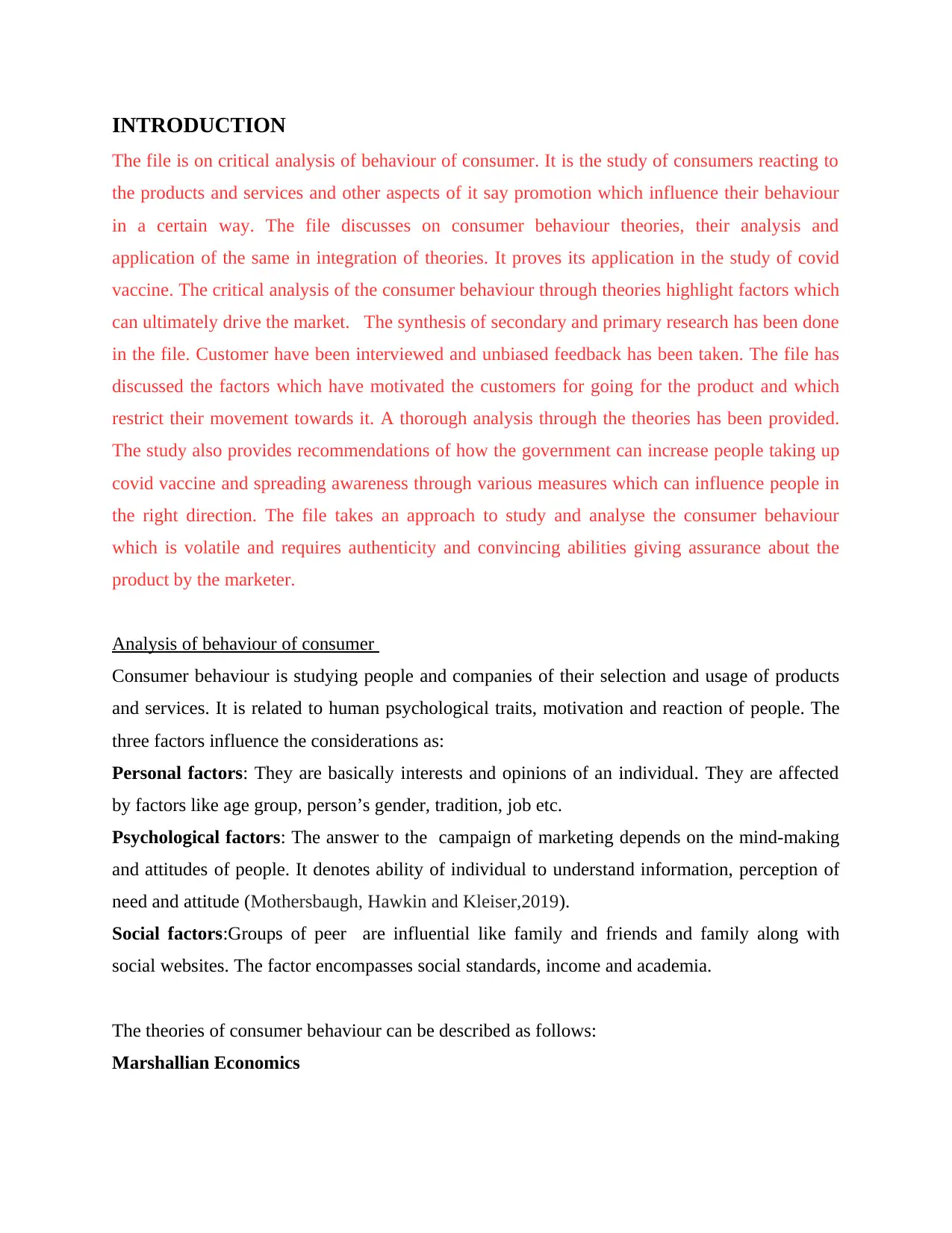
INTRODUCTION
The file is on critical analysis of behaviour of consumer. It is the study of consumers reacting to
the products and services and other aspects of it say promotion which influence their behaviour
in a certain way. The file discusses on consumer behaviour theories, their analysis and
application of the same in integration of theories. It proves its application in the study of covid
vaccine. The critical analysis of the consumer behaviour through theories highlight factors which
can ultimately drive the market. The synthesis of secondary and primary research has been done
in the file. Customer have been interviewed and unbiased feedback has been taken. The file has
discussed the factors which have motivated the customers for going for the product and which
restrict their movement towards it. A thorough analysis through the theories has been provided.
The study also provides recommendations of how the government can increase people taking up
covid vaccine and spreading awareness through various measures which can influence people in
the right direction. The file takes an approach to study and analyse the consumer behaviour
which is volatile and requires authenticity and convincing abilities giving assurance about the
product by the marketer.
Analysis of behaviour of consumer
Consumer behaviour is studying people and companies of their selection and usage of products
and services. It is related to human psychological traits, motivation and reaction of people. The
three factors influence the considerations as:
Personal factors: They are basically interests and opinions of an individual. They are affected
by factors like age group, person’s gender, tradition, job etc.
Psychological factors: The answer to the campaign of marketing depends on the mind-making
and attitudes of people. It denotes ability of individual to understand information, perception of
need and attitude (Mothersbaugh, Hawkin and Kleiser,2019).
Social factors:Groups of peer are influential like family and friends and family along with
social websites. The factor encompasses social standards, income and academia.
The theories of consumer behaviour can be described as follows:
Marshallian Economics
The file is on critical analysis of behaviour of consumer. It is the study of consumers reacting to
the products and services and other aspects of it say promotion which influence their behaviour
in a certain way. The file discusses on consumer behaviour theories, their analysis and
application of the same in integration of theories. It proves its application in the study of covid
vaccine. The critical analysis of the consumer behaviour through theories highlight factors which
can ultimately drive the market. The synthesis of secondary and primary research has been done
in the file. Customer have been interviewed and unbiased feedback has been taken. The file has
discussed the factors which have motivated the customers for going for the product and which
restrict their movement towards it. A thorough analysis through the theories has been provided.
The study also provides recommendations of how the government can increase people taking up
covid vaccine and spreading awareness through various measures which can influence people in
the right direction. The file takes an approach to study and analyse the consumer behaviour
which is volatile and requires authenticity and convincing abilities giving assurance about the
product by the marketer.
Analysis of behaviour of consumer
Consumer behaviour is studying people and companies of their selection and usage of products
and services. It is related to human psychological traits, motivation and reaction of people. The
three factors influence the considerations as:
Personal factors: They are basically interests and opinions of an individual. They are affected
by factors like age group, person’s gender, tradition, job etc.
Psychological factors: The answer to the campaign of marketing depends on the mind-making
and attitudes of people. It denotes ability of individual to understand information, perception of
need and attitude (Mothersbaugh, Hawkin and Kleiser,2019).
Social factors:Groups of peer are influential like family and friends and family along with
social websites. The factor encompasses social standards, income and academia.
The theories of consumer behaviour can be described as follows:
Marshallian Economics
⊘ This is a preview!⊘
Do you want full access?
Subscribe today to unlock all pages.

Trusted by 1+ million students worldwide
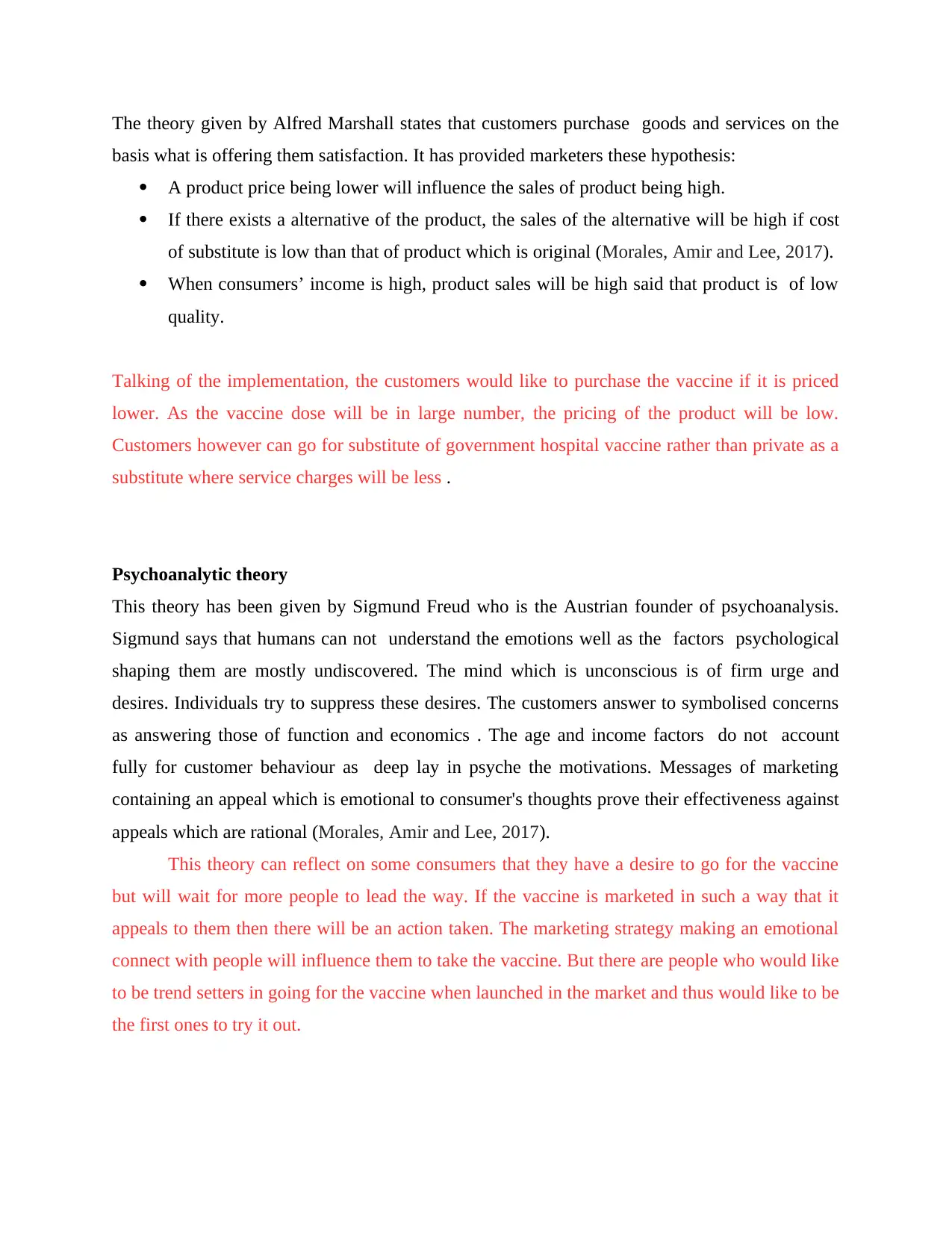
The theory given by Alfred Marshall states that customers purchase goods and services on the
basis what is offering them satisfaction. It has provided marketers these hypothesis:
A product price being lower will influence the sales of product being high.
If there exists a alternative of the product, the sales of the alternative will be high if cost
of substitute is low than that of product which is original (Morales, Amir and Lee, 2017).
When consumers’ income is high, product sales will be high said that product is of low
quality.
Talking of the implementation, the customers would like to purchase the vaccine if it is priced
lower. As the vaccine dose will be in large number, the pricing of the product will be low.
Customers however can go for substitute of government hospital vaccine rather than private as a
substitute where service charges will be less .
Psychoanalytic theory
This theory has been given by Sigmund Freud who is the Austrian founder of psychoanalysis.
Sigmund says that humans can not understand the emotions well as the factors psychological
shaping them are mostly undiscovered. The mind which is unconscious is of firm urge and
desires. Individuals try to suppress these desires. The customers answer to symbolised concerns
as answering those of function and economics . The age and income factors do not account
fully for customer behaviour as deep lay in psyche the motivations. Messages of marketing
containing an appeal which is emotional to consumer's thoughts prove their effectiveness against
appeals which are rational (Morales, Amir and Lee, 2017).
This theory can reflect on some consumers that they have a desire to go for the vaccine
but will wait for more people to lead the way. If the vaccine is marketed in such a way that it
appeals to them then there will be an action taken. The marketing strategy making an emotional
connect with people will influence them to take the vaccine. But there are people who would like
to be trend setters in going for the vaccine when launched in the market and thus would like to be
the first ones to try it out.
basis what is offering them satisfaction. It has provided marketers these hypothesis:
A product price being lower will influence the sales of product being high.
If there exists a alternative of the product, the sales of the alternative will be high if cost
of substitute is low than that of product which is original (Morales, Amir and Lee, 2017).
When consumers’ income is high, product sales will be high said that product is of low
quality.
Talking of the implementation, the customers would like to purchase the vaccine if it is priced
lower. As the vaccine dose will be in large number, the pricing of the product will be low.
Customers however can go for substitute of government hospital vaccine rather than private as a
substitute where service charges will be less .
Psychoanalytic theory
This theory has been given by Sigmund Freud who is the Austrian founder of psychoanalysis.
Sigmund says that humans can not understand the emotions well as the factors psychological
shaping them are mostly undiscovered. The mind which is unconscious is of firm urge and
desires. Individuals try to suppress these desires. The customers answer to symbolised concerns
as answering those of function and economics . The age and income factors do not account
fully for customer behaviour as deep lay in psyche the motivations. Messages of marketing
containing an appeal which is emotional to consumer's thoughts prove their effectiveness against
appeals which are rational (Morales, Amir and Lee, 2017).
This theory can reflect on some consumers that they have a desire to go for the vaccine
but will wait for more people to lead the way. If the vaccine is marketed in such a way that it
appeals to them then there will be an action taken. The marketing strategy making an emotional
connect with people will influence them to take the vaccine. But there are people who would like
to be trend setters in going for the vaccine when launched in the market and thus would like to be
the first ones to try it out.
Paraphrase This Document
Need a fresh take? Get an instant paraphrase of this document with our AI Paraphraser
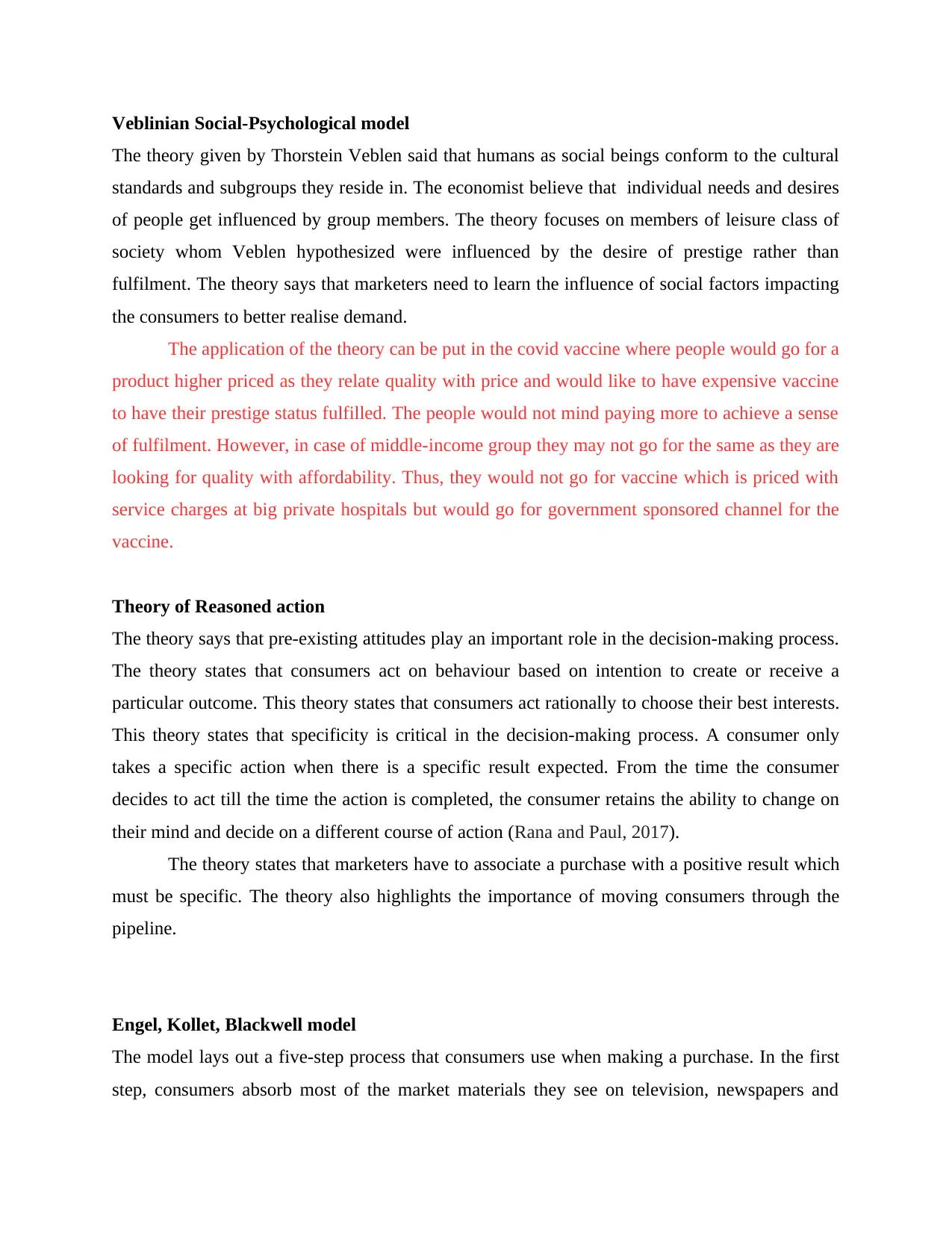
Veblinian Social-Psychological model
The theory given by Thorstein Veblen said that humans as social beings conform to the cultural
standards and subgroups they reside in. The economist believe that individual needs and desires
of people get influenced by group members. The theory focuses on members of leisure class of
society whom Veblen hypothesized were influenced by the desire of prestige rather than
fulfilment. The theory says that marketers need to learn the influence of social factors impacting
the consumers to better realise demand.
The application of the theory can be put in the covid vaccine where people would go for a
product higher priced as they relate quality with price and would like to have expensive vaccine
to have their prestige status fulfilled. The people would not mind paying more to achieve a sense
of fulfilment. However, in case of middle-income group they may not go for the same as they are
looking for quality with affordability. Thus, they would not go for vaccine which is priced with
service charges at big private hospitals but would go for government sponsored channel for the
vaccine.
Theory of Reasoned action
The theory says that pre-existing attitudes play an important role in the decision-making process.
The theory states that consumers act on behaviour based on intention to create or receive a
particular outcome. This theory states that consumers act rationally to choose their best interests.
This theory states that specificity is critical in the decision-making process. A consumer only
takes a specific action when there is a specific result expected. From the time the consumer
decides to act till the time the action is completed, the consumer retains the ability to change on
their mind and decide on a different course of action (Rana and Paul, 2017).
The theory states that marketers have to associate a purchase with a positive result which
must be specific. The theory also highlights the importance of moving consumers through the
pipeline.
Engel, Kollet, Blackwell model
The model lays out a five-step process that consumers use when making a purchase. In the first
step, consumers absorb most of the market materials they see on television, newspapers and
The theory given by Thorstein Veblen said that humans as social beings conform to the cultural
standards and subgroups they reside in. The economist believe that individual needs and desires
of people get influenced by group members. The theory focuses on members of leisure class of
society whom Veblen hypothesized were influenced by the desire of prestige rather than
fulfilment. The theory says that marketers need to learn the influence of social factors impacting
the consumers to better realise demand.
The application of the theory can be put in the covid vaccine where people would go for a
product higher priced as they relate quality with price and would like to have expensive vaccine
to have their prestige status fulfilled. The people would not mind paying more to achieve a sense
of fulfilment. However, in case of middle-income group they may not go for the same as they are
looking for quality with affordability. Thus, they would not go for vaccine which is priced with
service charges at big private hospitals but would go for government sponsored channel for the
vaccine.
Theory of Reasoned action
The theory says that pre-existing attitudes play an important role in the decision-making process.
The theory states that consumers act on behaviour based on intention to create or receive a
particular outcome. This theory states that consumers act rationally to choose their best interests.
This theory states that specificity is critical in the decision-making process. A consumer only
takes a specific action when there is a specific result expected. From the time the consumer
decides to act till the time the action is completed, the consumer retains the ability to change on
their mind and decide on a different course of action (Rana and Paul, 2017).
The theory states that marketers have to associate a purchase with a positive result which
must be specific. The theory also highlights the importance of moving consumers through the
pipeline.
Engel, Kollet, Blackwell model
The model lays out a five-step process that consumers use when making a purchase. In the first
step, consumers absorb most of the market materials they see on television, newspapers and
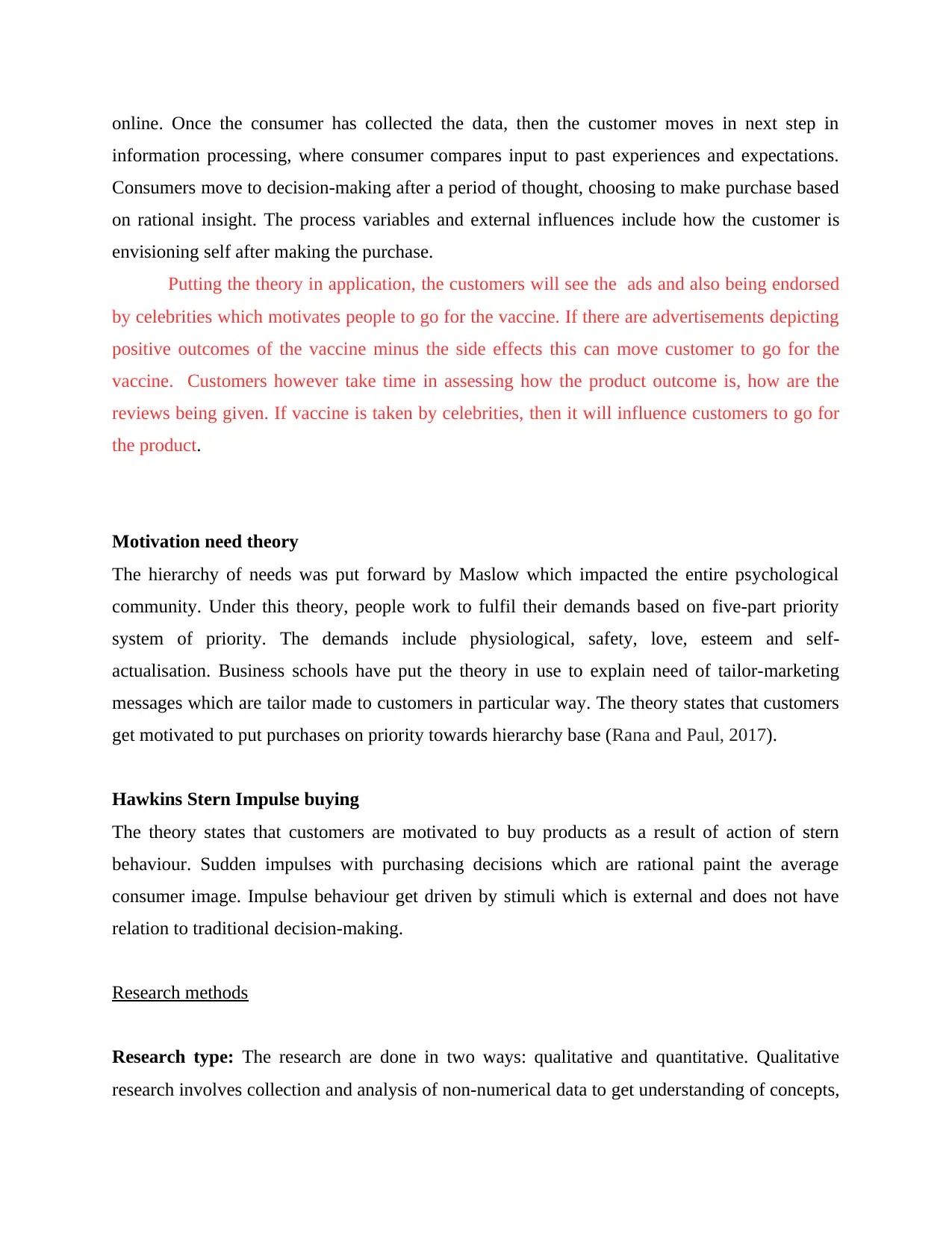
online. Once the consumer has collected the data, then the customer moves in next step in
information processing, where consumer compares input to past experiences and expectations.
Consumers move to decision-making after a period of thought, choosing to make purchase based
on rational insight. The process variables and external influences include how the customer is
envisioning self after making the purchase.
Putting the theory in application, the customers will see the ads and also being endorsed
by celebrities which motivates people to go for the vaccine. If there are advertisements depicting
positive outcomes of the vaccine minus the side effects this can move customer to go for the
vaccine. Customers however take time in assessing how the product outcome is, how are the
reviews being given. If vaccine is taken by celebrities, then it will influence customers to go for
the product.
Motivation need theory
The hierarchy of needs was put forward by Maslow which impacted the entire psychological
community. Under this theory, people work to fulfil their demands based on five-part priority
system of priority. The demands include physiological, safety, love, esteem and self-
actualisation. Business schools have put the theory in use to explain need of tailor-marketing
messages which are tailor made to customers in particular way. The theory states that customers
get motivated to put purchases on priority towards hierarchy base (Rana and Paul, 2017).
Hawkins Stern Impulse buying
The theory states that customers are motivated to buy products as a result of action of stern
behaviour. Sudden impulses with purchasing decisions which are rational paint the average
consumer image. Impulse behaviour get driven by stimuli which is external and does not have
relation to traditional decision-making.
Research methods
Research type: The research are done in two ways: qualitative and quantitative. Qualitative
research involves collection and analysis of non-numerical data to get understanding of concepts,
information processing, where consumer compares input to past experiences and expectations.
Consumers move to decision-making after a period of thought, choosing to make purchase based
on rational insight. The process variables and external influences include how the customer is
envisioning self after making the purchase.
Putting the theory in application, the customers will see the ads and also being endorsed
by celebrities which motivates people to go for the vaccine. If there are advertisements depicting
positive outcomes of the vaccine minus the side effects this can move customer to go for the
vaccine. Customers however take time in assessing how the product outcome is, how are the
reviews being given. If vaccine is taken by celebrities, then it will influence customers to go for
the product.
Motivation need theory
The hierarchy of needs was put forward by Maslow which impacted the entire psychological
community. Under this theory, people work to fulfil their demands based on five-part priority
system of priority. The demands include physiological, safety, love, esteem and self-
actualisation. Business schools have put the theory in use to explain need of tailor-marketing
messages which are tailor made to customers in particular way. The theory states that customers
get motivated to put purchases on priority towards hierarchy base (Rana and Paul, 2017).
Hawkins Stern Impulse buying
The theory states that customers are motivated to buy products as a result of action of stern
behaviour. Sudden impulses with purchasing decisions which are rational paint the average
consumer image. Impulse behaviour get driven by stimuli which is external and does not have
relation to traditional decision-making.
Research methods
Research type: The research are done in two ways: qualitative and quantitative. Qualitative
research involves collection and analysis of non-numerical data to get understanding of concepts,
⊘ This is a preview!⊘
Do you want full access?
Subscribe today to unlock all pages.

Trusted by 1+ million students worldwide
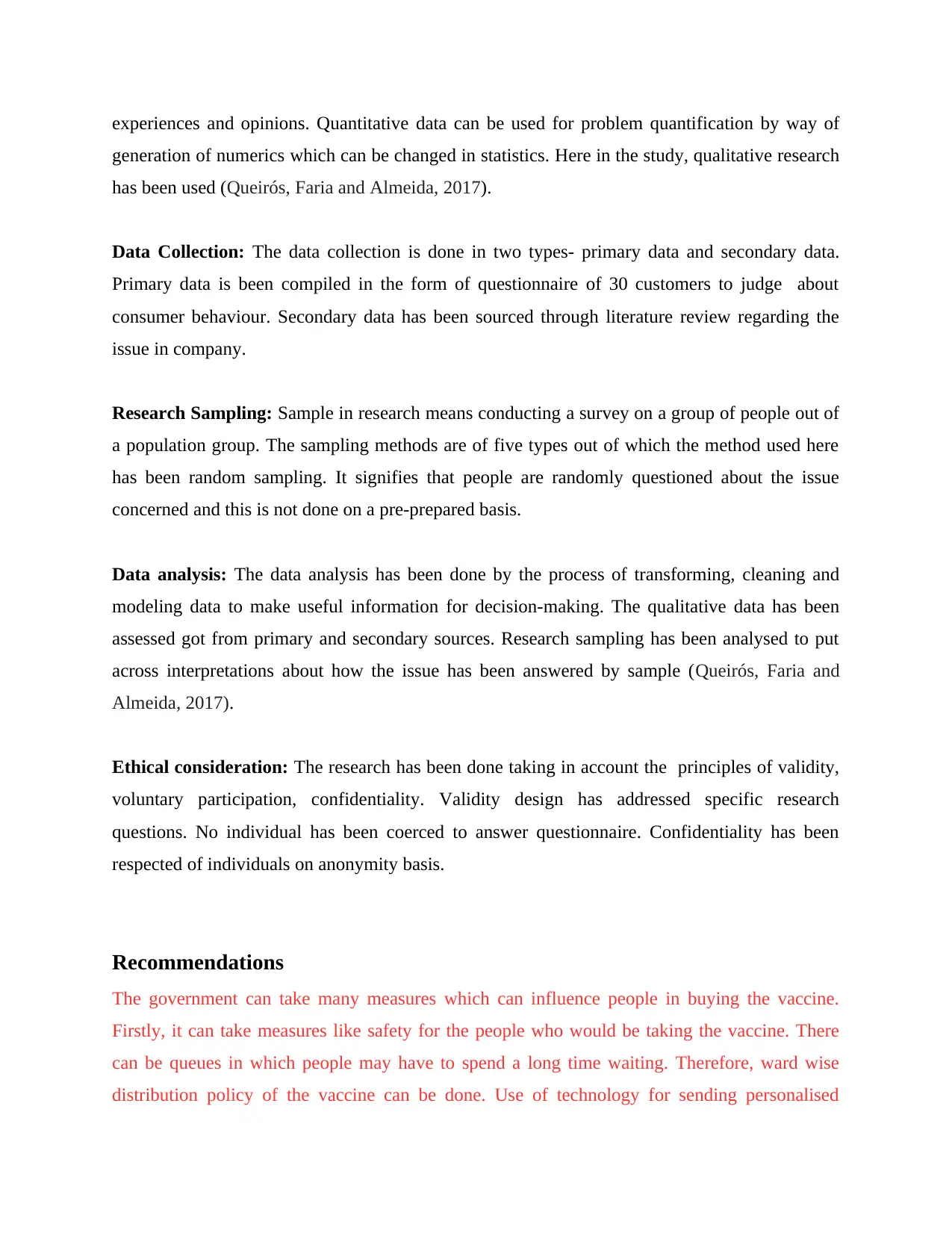
experiences and opinions. Quantitative data can be used for problem quantification by way of
generation of numerics which can be changed in statistics. Here in the study, qualitative research
has been used (Queirós, Faria and Almeida, 2017).
Data Collection: The data collection is done in two types- primary data and secondary data.
Primary data is been compiled in the form of questionnaire of 30 customers to judge about
consumer behaviour. Secondary data has been sourced through literature review regarding the
issue in company.
Research Sampling: Sample in research means conducting a survey on a group of people out of
a population group. The sampling methods are of five types out of which the method used here
has been random sampling. It signifies that people are randomly questioned about the issue
concerned and this is not done on a pre-prepared basis.
Data analysis: The data analysis has been done by the process of transforming, cleaning and
modeling data to make useful information for decision-making. The qualitative data has been
assessed got from primary and secondary sources. Research sampling has been analysed to put
across interpretations about how the issue has been answered by sample (Queirós, Faria and
Almeida, 2017).
Ethical consideration: The research has been done taking in account the principles of validity,
voluntary participation, confidentiality. Validity design has addressed specific research
questions. No individual has been coerced to answer questionnaire. Confidentiality has been
respected of individuals on anonymity basis.
Recommendations
The government can take many measures which can influence people in buying the vaccine.
Firstly, it can take measures like safety for the people who would be taking the vaccine. There
can be queues in which people may have to spend a long time waiting. Therefore, ward wise
distribution policy of the vaccine can be done. Use of technology for sending personalised
generation of numerics which can be changed in statistics. Here in the study, qualitative research
has been used (Queirós, Faria and Almeida, 2017).
Data Collection: The data collection is done in two types- primary data and secondary data.
Primary data is been compiled in the form of questionnaire of 30 customers to judge about
consumer behaviour. Secondary data has been sourced through literature review regarding the
issue in company.
Research Sampling: Sample in research means conducting a survey on a group of people out of
a population group. The sampling methods are of five types out of which the method used here
has been random sampling. It signifies that people are randomly questioned about the issue
concerned and this is not done on a pre-prepared basis.
Data analysis: The data analysis has been done by the process of transforming, cleaning and
modeling data to make useful information for decision-making. The qualitative data has been
assessed got from primary and secondary sources. Research sampling has been analysed to put
across interpretations about how the issue has been answered by sample (Queirós, Faria and
Almeida, 2017).
Ethical consideration: The research has been done taking in account the principles of validity,
voluntary participation, confidentiality. Validity design has addressed specific research
questions. No individual has been coerced to answer questionnaire. Confidentiality has been
respected of individuals on anonymity basis.
Recommendations
The government can take many measures which can influence people in buying the vaccine.
Firstly, it can take measures like safety for the people who would be taking the vaccine. There
can be queues in which people may have to spend a long time waiting. Therefore, ward wise
distribution policy of the vaccine can be done. Use of technology for sending personalised
Paraphrase This Document
Need a fresh take? Get an instant paraphrase of this document with our AI Paraphraser
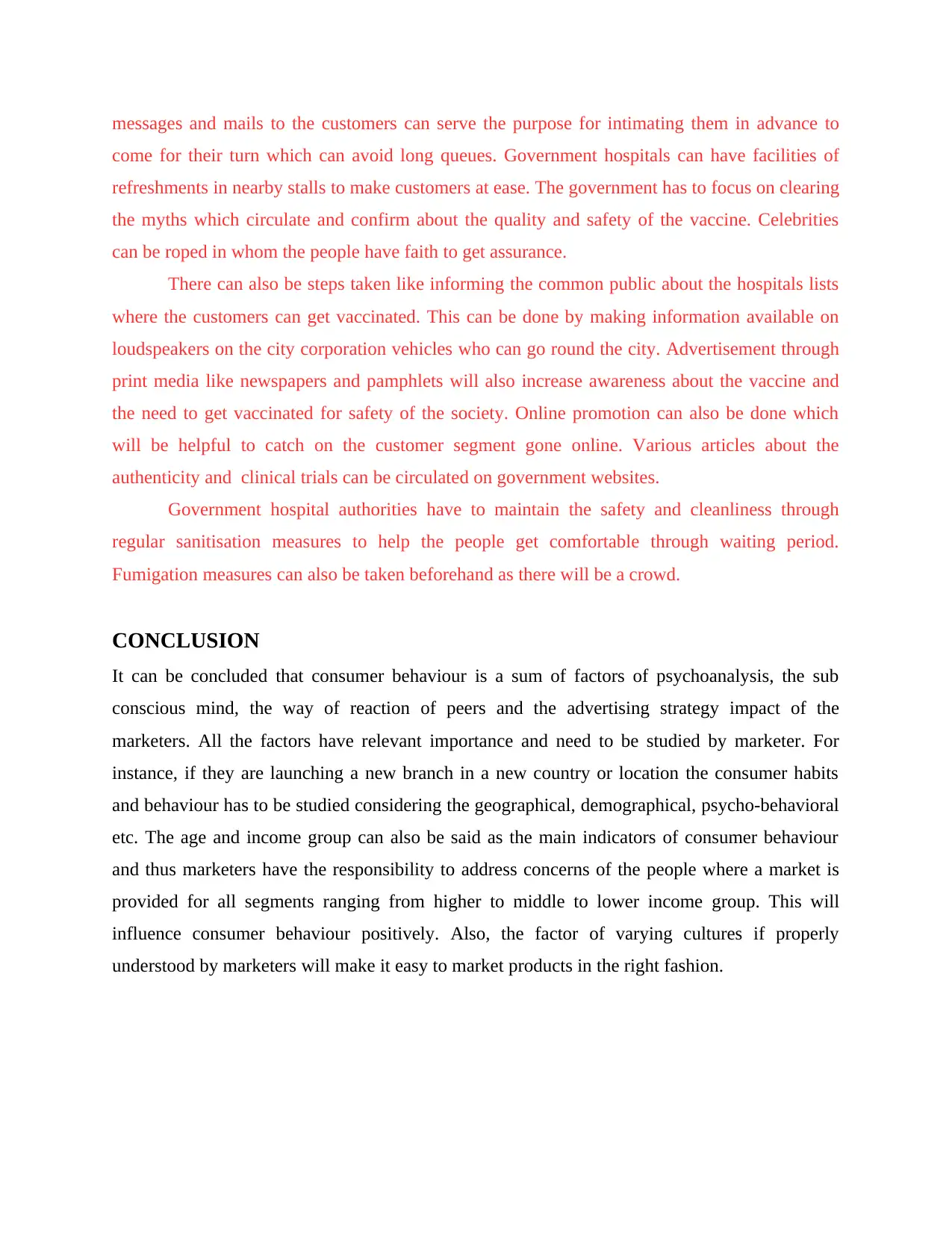
messages and mails to the customers can serve the purpose for intimating them in advance to
come for their turn which can avoid long queues. Government hospitals can have facilities of
refreshments in nearby stalls to make customers at ease. The government has to focus on clearing
the myths which circulate and confirm about the quality and safety of the vaccine. Celebrities
can be roped in whom the people have faith to get assurance.
There can also be steps taken like informing the common public about the hospitals lists
where the customers can get vaccinated. This can be done by making information available on
loudspeakers on the city corporation vehicles who can go round the city. Advertisement through
print media like newspapers and pamphlets will also increase awareness about the vaccine and
the need to get vaccinated for safety of the society. Online promotion can also be done which
will be helpful to catch on the customer segment gone online. Various articles about the
authenticity and clinical trials can be circulated on government websites.
Government hospital authorities have to maintain the safety and cleanliness through
regular sanitisation measures to help the people get comfortable through waiting period.
Fumigation measures can also be taken beforehand as there will be a crowd.
CONCLUSION
It can be concluded that consumer behaviour is a sum of factors of psychoanalysis, the sub
conscious mind, the way of reaction of peers and the advertising strategy impact of the
marketers. All the factors have relevant importance and need to be studied by marketer. For
instance, if they are launching a new branch in a new country or location the consumer habits
and behaviour has to be studied considering the geographical, demographical, psycho-behavioral
etc. The age and income group can also be said as the main indicators of consumer behaviour
and thus marketers have the responsibility to address concerns of the people where a market is
provided for all segments ranging from higher to middle to lower income group. This will
influence consumer behaviour positively. Also, the factor of varying cultures if properly
understood by marketers will make it easy to market products in the right fashion.
come for their turn which can avoid long queues. Government hospitals can have facilities of
refreshments in nearby stalls to make customers at ease. The government has to focus on clearing
the myths which circulate and confirm about the quality and safety of the vaccine. Celebrities
can be roped in whom the people have faith to get assurance.
There can also be steps taken like informing the common public about the hospitals lists
where the customers can get vaccinated. This can be done by making information available on
loudspeakers on the city corporation vehicles who can go round the city. Advertisement through
print media like newspapers and pamphlets will also increase awareness about the vaccine and
the need to get vaccinated for safety of the society. Online promotion can also be done which
will be helpful to catch on the customer segment gone online. Various articles about the
authenticity and clinical trials can be circulated on government websites.
Government hospital authorities have to maintain the safety and cleanliness through
regular sanitisation measures to help the people get comfortable through waiting period.
Fumigation measures can also be taken beforehand as there will be a crowd.
CONCLUSION
It can be concluded that consumer behaviour is a sum of factors of psychoanalysis, the sub
conscious mind, the way of reaction of peers and the advertising strategy impact of the
marketers. All the factors have relevant importance and need to be studied by marketer. For
instance, if they are launching a new branch in a new country or location the consumer habits
and behaviour has to be studied considering the geographical, demographical, psycho-behavioral
etc. The age and income group can also be said as the main indicators of consumer behaviour
and thus marketers have the responsibility to address concerns of the people where a market is
provided for all segments ranging from higher to middle to lower income group. This will
influence consumer behaviour positively. Also, the factor of varying cultures if properly
understood by marketers will make it easy to market products in the right fashion.
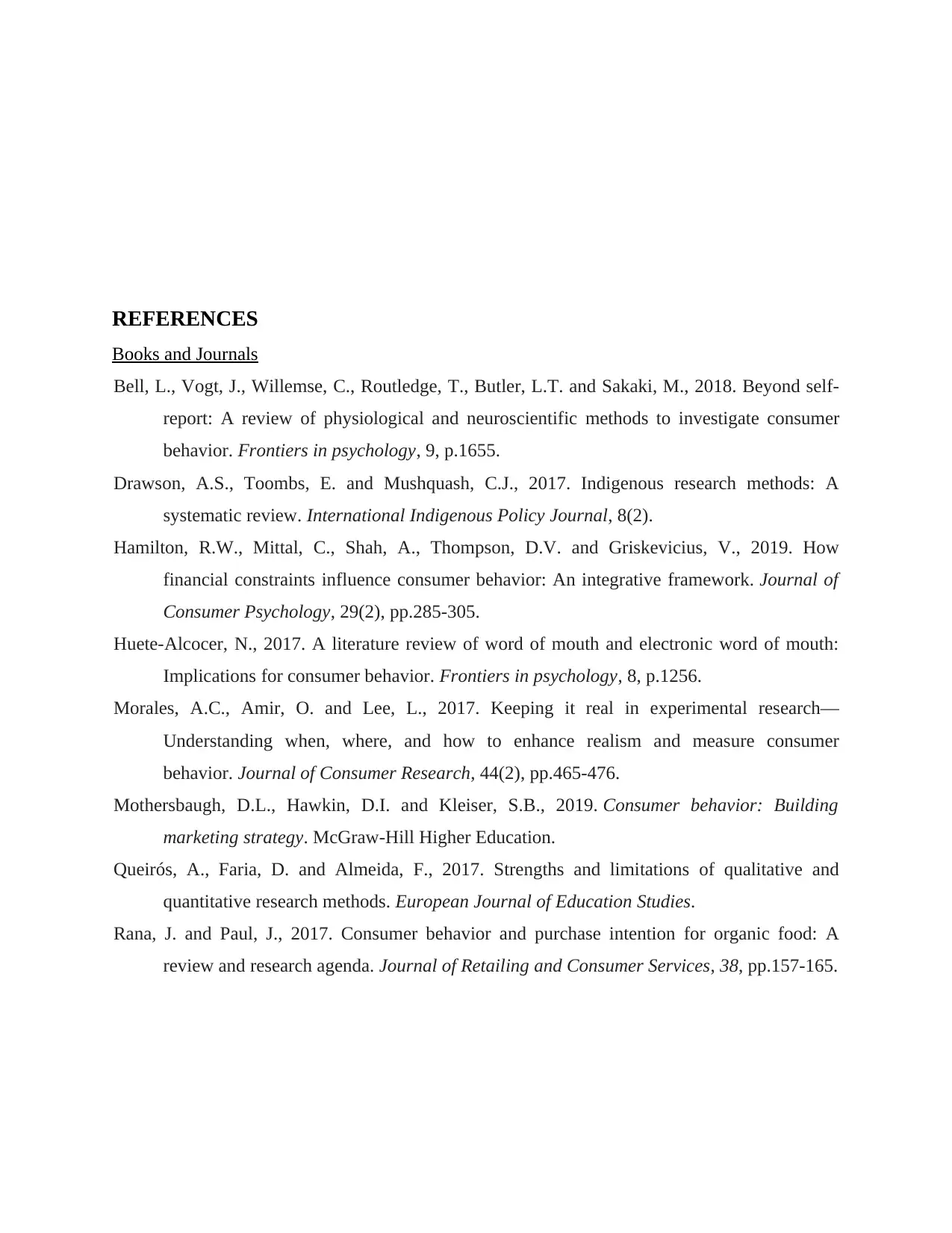
REFERENCES
Books and Journals
Bell, L., Vogt, J., Willemse, C., Routledge, T., Butler, L.T. and Sakaki, M., 2018. Beyond self-
report: A review of physiological and neuroscientific methods to investigate consumer
behavior. Frontiers in psychology, 9, p.1655.
Drawson, A.S., Toombs, E. and Mushquash, C.J., 2017. Indigenous research methods: A
systematic review. International Indigenous Policy Journal, 8(2).
Hamilton, R.W., Mittal, C., Shah, A., Thompson, D.V. and Griskevicius, V., 2019. How
financial constraints influence consumer behavior: An integrative framework. Journal of
Consumer Psychology, 29(2), pp.285-305.
Huete-Alcocer, N., 2017. A literature review of word of mouth and electronic word of mouth:
Implications for consumer behavior. Frontiers in psychology, 8, p.1256.
Morales, A.C., Amir, O. and Lee, L., 2017. Keeping it real in experimental research—
Understanding when, where, and how to enhance realism and measure consumer
behavior. Journal of Consumer Research, 44(2), pp.465-476.
Mothersbaugh, D.L., Hawkin, D.I. and Kleiser, S.B., 2019. Consumer behavior: Building
marketing strategy. McGraw-Hill Higher Education.
Queirós, A., Faria, D. and Almeida, F., 2017. Strengths and limitations of qualitative and
quantitative research methods. European Journal of Education Studies.
Rana, J. and Paul, J., 2017. Consumer behavior and purchase intention for organic food: A
review and research agenda. Journal of Retailing and Consumer Services, 38, pp.157-165.
Books and Journals
Bell, L., Vogt, J., Willemse, C., Routledge, T., Butler, L.T. and Sakaki, M., 2018. Beyond self-
report: A review of physiological and neuroscientific methods to investigate consumer
behavior. Frontiers in psychology, 9, p.1655.
Drawson, A.S., Toombs, E. and Mushquash, C.J., 2017. Indigenous research methods: A
systematic review. International Indigenous Policy Journal, 8(2).
Hamilton, R.W., Mittal, C., Shah, A., Thompson, D.V. and Griskevicius, V., 2019. How
financial constraints influence consumer behavior: An integrative framework. Journal of
Consumer Psychology, 29(2), pp.285-305.
Huete-Alcocer, N., 2017. A literature review of word of mouth and electronic word of mouth:
Implications for consumer behavior. Frontiers in psychology, 8, p.1256.
Morales, A.C., Amir, O. and Lee, L., 2017. Keeping it real in experimental research—
Understanding when, where, and how to enhance realism and measure consumer
behavior. Journal of Consumer Research, 44(2), pp.465-476.
Mothersbaugh, D.L., Hawkin, D.I. and Kleiser, S.B., 2019. Consumer behavior: Building
marketing strategy. McGraw-Hill Higher Education.
Queirós, A., Faria, D. and Almeida, F., 2017. Strengths and limitations of qualitative and
quantitative research methods. European Journal of Education Studies.
Rana, J. and Paul, J., 2017. Consumer behavior and purchase intention for organic food: A
review and research agenda. Journal of Retailing and Consumer Services, 38, pp.157-165.
⊘ This is a preview!⊘
Do you want full access?
Subscribe today to unlock all pages.

Trusted by 1+ million students worldwide
1 out of 9
Related Documents
Your All-in-One AI-Powered Toolkit for Academic Success.
+13062052269
info@desklib.com
Available 24*7 on WhatsApp / Email
![[object Object]](/_next/static/media/star-bottom.7253800d.svg)
Unlock your academic potential
Copyright © 2020–2025 A2Z Services. All Rights Reserved. Developed and managed by ZUCOL.





